Abstract
This paper deals with well-known weak homotopy equivalences that relate homotopy colimits of small categories and simplicial sets. We show that these weak homotopy equivalences have stronger cohomology-preserving properties than for local coefficients.
MSC:
18G30; 18G60; 55U10; 55U35
1. Introduction
Since the 1980 paper by Thomason [], we know that the categories , of simplicial sets, and , of small categories, are equivalent from a homotopical point of view. Indeed, there are several basic functorial constructions by which one can pass freely between these categories, preserving all the homotopy invariants of their objects and morphisms. For instance, we have the functor which assigns to each small category its nerve , and the functor sending each simplicial set X to its category of simplices .
Nevertheless, there are interesting algebraic constructions, both on simplicial sets and on small categories, that are not invariants of their homotopy type. This is the case for Gabriel–Zisman cohomology groups ([] Appendix II), of simplicial sets X with arbitrary coefficient systems on them, that is, with coefficients in abelian group valued functors . Recall from Quillen ([] II §3, Prop. 4) that a simplicial map is a weak homotopy equivalence if and only if it induces an equivalence of fundamental groupoids , as well isomorphisms , for all , whenever is a local coefficient system on X, that is, whenever is a morphism-inverting functor or, equivalently, if is actually an abelian group valued functor on the fundamental groupoid of X. Similarly, Baues–Wirsching cohomology groups [], of a small category with coefficients in natural systems on it, that is, with coefficients in abelian group valued functors on its category of factorizations , are homotopy invariants of only for local coefficients .
There are, however, some particular weak homotopy equivalences that have a stronger conservation property of cohomology than for local coefficients. For instance, for any small category , the morphism between end vertices functor is a weak homotopy equivalence of categories which induces isomorphisms for any natural system of coefficients on . The aim of this paper is to prove that two relevant and well-known weak homotopy equivalences have similar strong cohomology-preserving properties. These come respectively associated to diagrams of small categories and simplicial sets. The first of them arises from the seminal Homotopy Colimit Theorem by Thomason ([] Theorem 1.2). This theorem states that, for any indexing small category and any functor , there is a natural weak homotopy equivalence of simplicial sets
between the homotopy colimit of the -diagram of simplicial sets , obtained by applying the nerve construction to each category , and the nerve of the category obtained by applying the Grothendieck construction on F, see (9) below for details. Thus, the Grothendieck construction on a diagram of small categories represents its homotopy colimit with respect to the Thomason model structure in []. Since one easily sees that the simplicial map induces an isomorphism between the associated fundamental groupoids (see ([] p. 95)), Thomason’s theorem is actually equivalent to the fact that induces isomorphisms
for every local coefficient system on the category . We prove here the following stronger result.
Theorem 1.
For any natural system , the isomorphisms (Equation (1)) hold.
The proof we give of this theorem is independent of that given by Thomason in [] of his Homotopy Colimit Theorem, so that this latter appears now as a consequence.
Going in the opposite direction, we also consider diagrams of simplicial sets. For any functor , there is a known natural weak homotopy equivalence in
between the category of simplices of the homotopy colimit of G and the Grothendieck construction on the diagram of small categories , obtained by applying the category of simplices construction to each simplicial set , see Equation (29) below for details. Then, for any local coefficient system , the functor induces isomorphisms
Our second main result in the paper is the following.
Theorem 2.
For any coefficient system , the isomorphisms (Equation (2)) hold.
We show several consequences of the above theorems. For instance, given a functor and a natural system on , for any morphism in , there is an induced natural system on the category . We describe a first quadrant spectral sequence
where is the natural system on that assigns to each morphism the cohomology group . This spectral sequence reduces to that constructed by Pirashvili–Redondo in ([] Theorem 5.2) when the natural system of coefficients is h-local (see also Gálvez–Neumann–Tonks ([] Theorem 2.5) and ([] Theorem 2.16)). In the other direction, given a functor , for a coefficient system on and an object c of , there is an induced coefficient system on the simplicial set . We describe a Bousfield–Kan type first quadrant spectral sequence (cf. ([] XII, 4.5, 5.8))
where is the functor that assigns to each object c of the cohomology group . Various invariance results appears here as corollaries. Some of them are already known, such as the Invariance Theorem by Moerdijk–Svensson ([] Theorem 2.3), but others are new. For example, if are diagrams of categories and a natural transformation such that every functor , , is a weak homotopy equivalence having the Baues–Wirsching cohomology-preserving property, then the induced is also a weak homotopy equivalence with the same cohomology-preserving property.
The plan of the paper is simple. After this introductory section, the preliminary Section 2 comprises some notations and a brief review of notions and facts concerning cohomology of small categories and simplicial sets, and Section 3 and Section 4 are essentially dedicated to proving Theorems 1 and 2 above, respectively. Although the proofs of both theorems follow a similar strategy, they are independent.
2. Preliminaries
This section aims to make this paper as self-contained as possible; hence, at the same time as fixing notations and terminology, we review some needed constructions and facts concerning cohomology of small categories and simplicial sets.
Throughout the paper, the composition of maps between sets, homomorphisms between abelian groups, and functors between categories, is written by juxtaposition. The composition of arrows in any abstract small category is denoted by the symbol ∘.
2.1. Cohomology of Small Categories
If is any small category, then the category of -modules, denoted -Mod, has as objects the abelian group valued functors , with morphisms the natural transformations between them. If is any -module and is a morphism in , then we write the associated homomorphism by .
The category -Mod is abelian. We refer to Mac Lane ([] Chapter IX, §3) for details, but recall that the set of morphisms between two -modules and , denoted by , is an abelian group by pointwise addition, that is, if are morphisms, then is defined by setting , for each object . The zero -module is the constant functor defined by the trivial abelian group 0, and a sequence of -modules is exact if and only if all the induced sequences of abelian groups are exact.
Furthermore, the category -Mod has enough projective objects. A way to see this is by means of free -modules: There is a forgetful functor , from the category of -modules to the comma category of sets over the set of objects of , which carries a -module to the disjoint union set
endowed with the projection map , given by . If is any morphism of -modules, then is defined by . This functor has a left adjoint, the free -module functor, , which is defined as follows. If is any set over , then
is the -module that assigns to each the free abelian group with generators all pairs consisting of an element together with a morphism of . We usually write simply by s, so that each element of is regarded as an element of . For any morphism in , the homomorphism is defined on generators by . Thus, for any generator of , we have the equality , where is the homomorphism induced by u. If is any map of sets over (so that ), the induced is the morphism whose component at an object a of is the homomorphism such that .
Proposition 1.
The functor is left adjoint to the functor . Thus, for any set over and any -module , there is a natural isomorphism
Proof.
This follows from the Yoneda Lemma. For any list , the unique morphism of -modules such that , for all , consists of the homomorphisms , , defined on generators by . □
From the above proposition, it is plain to see that any free -module is projective and, moreover, the counit is a projective presentation of any -module .
Let
be the -module that associates to each the free abelian group on the generator a, and to each morphism the isomorphism of abelian groups such that . This is isomorphic to the constant functor on defined by the abelian group .
The cohomology groups of a small category with coefficients in a -module (cf., e.g., Gabriel–Zisman [], Illusie [], Roos [], and Watts []), are defined as
2.2. Baues–Wirsching Cohomology of Small Categories
If is any small category, its category of factorizations, , is the category whose objects are the morphisms in , and whose morphisms are pairs of morphisms of such that , that is, making commutative the square below.


Composition is given by the formula . The identity arrow at any is the pair . In [], Baues and Wirsching call such -modules by the name of natural systems on , and they define the cohomology groups of with coefficients in a natural system to be those of its category of factorizations (see ([] Theorem (4.4))):
Notation: If is a natural system, for any two composible arrows in , we denote the induced homomorphisms and briefly by
respectively. Thus, for any composible arrows , the equalities below hold.
Baues–Wirsching cohomology recovers the cohomology of a small category with coefficients in -modules, as follows. There is a canonical target functor
sending a morphism in to . By composing with this functor t, every -module gives rise to a natural system on , which is equally denoted . This way, every -module is regarded as a natural system on and, by ([] Proposition (8.5)), there are natural isomorphisms , so that both Equations (3) and (4), for coefficients in -modules, are the same.
2.3. Cohomology of Simplicial Sets
As usual, let denote the simplicial category, whose objects are the finite ordered sets , and morphisms the weakly order-preserving maps between them. The coface maps are denoted by , . Recall that these are the injections that omit the ith element. We denote by the category of simplicial sets. If is any simplicial set, for any map in , we write the attached map by . In particular, the face maps are denoted by .
The category of simplices of a simplicial set X is denoted by . This has as objects the pairs where and , and an arrow is map in such that . The assignment is the function on objects of a functor , from the category of simplicial sets to the category of small categories, which carries a simplicial map to the functor sending an arrow of to the arrow of .
A coefficient system on a simplicial set X is a -module, that is, a functor . To shorten notation, for an object of , we usually write instead of , leaving understood the dimension n of the simplex x. Thus, if is a morphism in , the associated homomorphism is written as . In particular, for any , we have the coface homomorphisms
The cohomology groups of a simplicial set X with coefficients -module are defined to be those of its category of simplices (cf., e.g., Illusie ([] Chapitre VI §3) and Gabriel–Zisman ([] Appendix II)), that is,
Remark 1.
A -module is called a local coefficient system on the simplicial set X (see Goerss–Jardine ([] Chapter III §1) and Gabriel–Zisman ([] Appendix II, 4.7)) whenever, for any map of Δ and any n-simplex x of X, the induced homomorphism is an isomorphism. A weak homotopy equivalence induces isomorphisms , provided is a local coefficient system on X, see Quillen ([] Chapter II, §3, Prop. 4). However, for arbitrary coefficient systems on a simplicial set X, the cohomology groups are not invariants of the homotopy type of X.
The standard cochain complex , of a simplicial set X with coefficients in a -module , consists of the abelian groups
with coboundary given by . In Section 4 below (see Corollary 8) there is a proof of the following well-known fact (see Illusie ([] Chapitre VI, (3.4.3))) and Gabriel–Zisman ([] Appendix II, Prop. 4.2).
Fact 1.
For any coefficient system on a simplicial set X, there are natural isomorphisms
2.4. The Nerve of a Small Category
We usually regard the ordered sets of as categories with only one arrow whenever , and the maps in as functors. The nerve of any small category is the simplicial set whose n-simplices are the functors , and the map , induced by a map , is given by . The functor nerve carries a functor to the simplicial map such that .
From now on, we will employ several times the following notation: If is a functor, then we write for the morphism . Thus, for any in , we have
The morphism between end vertices functor is denoted by
This carries any object of to the morphism of , and carries a morphism of to the morphism of
depicted as below.


By composing with this functor e, every natural system on produces a coefficient system on the simplicial set , which is denoted also by . In Section 3 below (see Corollary 1) there is a proof of the following well-known fact (cf. Baues–Wirsching ([] Definition (1.4), Theorem (4.4)), Illusie ([] Chapitre VI, (3.4.2)), and Gabriel–Zisman ([] Appendix II, Proposition 3.3)).
Fact 2.
For any natural system on a small category , there are natural isomorphisms
Let us stress that, after Fact 1, it is implicit in the above Fact 2 that, for any natural system on , the cohomology groups can be computed by means of the standard cochain complex , which is denoted in [] by . Thus,
and the coboundary is given by
Also, let us point out that the composition of the functors in Equations (7) and (5),
is just the last vertex functor, which sends each object of to the object of . By composition with it, any -module defines a coefficient system on and, in this way, Fact 2 applies to the ordinary cohomology groups of with coefficients in -modules.
Remark 2.
For a small category , arbitrary coefficient systems on , that is, arbitrary functors , are called Thomason natural systems on by Gálvez–Carrillo–Neumann–Tonks in [], where the cohomology groups are denoted by and studied under the name of Thomason cohomology groups of the category.
3. On the Weak Equivalence
Throughout this section, denotes a functor, where is a small category. For a morphism of , we write for the functor . Thus, for any n-simplex of , that is, for any functor , we have functors (see Equation (6) for the notation)
3.1. The Involved Constructions
By composing F with the nerve functor, we get a diagram of simplicial sets , whose homotopy colimit ([] Chapter XII, §5) is denoted by . This simplicial set has as n-simplices pairs of functors , where and and, for any map in , the induced acts by
In particular, its face operators are given by
On the other hand, the Grothendieck construction [,,] on the diagram F yields a small category, denoted by , whose objects are pairs where a is an object of and x is an object of . A morphism form to in is a pair with a morphism in and a morphism in . Arrows in compose by the formula
The Thomason weak equivalence ([] Theorem 1.2) is the simplicial map
which carries an n-simplex of the homotopy colimit to the n-simplex of the nerve of the Grothendieck construction defined by
3.2. A Free Resolution of the Natural System over
The following construction is key for our main result in this section.
Let be the simplicial replacement construction of Bousfield–Kan ([] Chapter XII, §5) on : that is, the bisimplicial set
whose -simplices are pairs of functors where and . If and are maps in , the induced maps
are defined on a -simplex as above by
In particular, its face operators act by
Now, for each integers , let the set be endowed with the morphism between end vertices map , defined by
and let be the corresponding free -module (i.e., free natural system on ). Thus, for each morphism in ,
is the free abelian group with generators the sextuples , where
such that
Note that the latter equations mean that the square in the category below commutes.


For any three composible morphisms in ,
the induced homomorphisms
are, respectively, given on generators by
These provide a bisimplicial natural system on
where, for any maps in the simplicial category, and , the induced and are the morphisms whose respective components at a morphism of are the homomorphisms and respectively defined on generators by
In particular, the horizontal and vertical face homomorphisms
act on generators by
Let be the complex associated to the simplicial natural system diagonal of : that is, the cochain complex of natural systems on with , and whose differential , at a morphism of , is given on generators by
Lemma 1.
is a projective resolution of the natural system on . Therefore, for any natural system on ,
Proof.
Let us write as in Equation (11). Let be the morphism of natural systems whose component , at a morphism of , is the homomorphism defined on generators by
where we have identified any object of with the functor such that and, similarly, an object of with the functor with . It is easily seen that this morphism determines an augmentation .
Since every natural system is free, whence projective, it suffices to prove that, for any morphism of , the augmented chain complex of abelian groups
is exact. To do this, let us fix such a morphism and proceed as follows.
For each , let be the free abelian group on the set of triples consisting of a functor and morphisms and of with , that is, making commutative the square


These define a simplicial abelian group , where each map of induces the homomorphism defined on generators by
In particular, its face homomorphisms are defined by
This simplicial abelian group can be endowed with an augmentation over by the homomorphism which acts on generators by . Let us also denote by the associated chain complex, in which the differentials are obtained by taking alternating sums. The resulting augmented chain complex of abelian groups admits a contracting homotopy k
 whence it is exact. Such a contraction k is given by the homomorphisms and , which act on generators by
whence it is exact. Such a contraction k is given by the homomorphisms and , which act on generators by

In the above formula, for any functor and any morphism , the functor is defined by
To check that is actually a chain homotopy, we first observe the equalities
From these, it is not hard to see that the operators satisfy the equations
whence the equality follows for all .
Consider now the simplicial abelian group as a bisimplicial abelian group which is constant in the horizontal direction. Then, the homomorphisms defined on generators by
determine a bisimplicial homomorphism . For every , the associated augmented chain complex of abelian groups
 is exact, because of it admits a contracting homotopy h given by the homomorphisms and which act on generators by
where, for any functor and any morphism , the functor is defined by the formulas
is exact, because of it admits a contracting homotopy h given by the homomorphisms and which act on generators by
where, for any functor and any morphism , the functor is defined by the formulas

As above, to check that h is actually a contracting chain homotopy, we first observe the equalities
From these, we see that the operators satisfy the equations
whence the equality follows.
Let us now consider the category of simplices , whose objects are triples , where and are functors, and whose morphisms are those maps in such that and . We have the composite functor ,
of the functor induced by Thomason simplicial map Equation (9) with the morphism between end vertices functor e Equation (7). This functor carries each object to the morphism of
and a morphism , as above, to the morphism of the category of factorizations given by the broken arrows below.


Then, by composition with , any natural system on gives rise to a coefficient system, denoted by , on the simplicial set . As a main result in this paper, we have
Theorem 3.
For any natural system on , the Thomason map η in Equation (9) induces isomorphisms
Proof.
For any given natural system on , the coefficient system on the homotopy colimit carries an n-simplex to the abelian group
and, for any map in the simplicial category, the induced homomorphism is the homomorphism
In particular, for any n-simplex of , the coface homomorphisms
are
Then, the standard cochain complex consists of the abelian groups
with coboundary given by
Now, let be the bisimplicial natural system in Equation (11). By Proposition 1, for every , there is an isomorphism of abelian groups
which carries any n-cochain to the morphism of natural systems whose component at every morphism of is the homomorphism of abelian groups
These morphisms fit together to define an isomorphism of cochain complexes
In effect, for any , any morphism of , and any generator of , we have
Hence, the result follows from Lemma 1 and Fact 1 (=Corollary 8 below). □
Theorem 3 above is actually a natural generalization of the useful and well-known result below, already presented as Fact 2 in the preliminary Section 2.
Corollary 1.
Let be a small category. For any natural system on , there are natural isomorphisms
Proof.
Let us specialize Theorem 3 to the case when is the constant functor defined by the only-one-arrow category . In this case, , , and the Thomason simplicial map Equation (9), , is the identity map on . Therefore, Theorem 3 just says that, for any natural system on , there are isomorphisms . □
Particular cases of the following corollary have been used several times in homological algebra to compute cohomology of semidirect products of groups or monoids, diagrams of groups, etc. (see, e.g., Cegarra [,]), by means of certain chain complexes more manageable than the standard ones.
Let be the bisimplicial natural system on in Equation (11), and let be any given natural system on . By Proposition 1, there is a natural isomorphism of bicosimplicial abelian groups
where is the bicosimplicial abelian group described as follows: for every integers ,
and, for any maps and in the simplicial category, the induced homomorphisms
are defined by
In particular, its horizontal and vertical coface homomorphisms
are given by the formulas
Define the non-standard cochain complex of with coefficients in a natural system to be , the total cochain complex of the associated double cochain complex to . Thus, it consists of the abelian groups
with coboundary given by
Corollary 2.
For any natural system on , there are natural isomorphisms
Proof.
From the descriptions of the bicomplex in Equations (18) and (17) and the complex in Equations (19)–(21), a straightforward comparison shows that . Then the result follows from Theorem 3, since both cochain complexes and are cohomology equivalent by the generalized Eilenberg–Zilber theorem of Dold and Puppe (see, e.g., Goerss–Jardine ([] Chapter IV, Theorem 2.4)). □
Spectral sequences for the cohomology of the Grotendieck construction are implicit in the above corollary. Let be a natural system on . Every arrow in determines a functor between the categories of factorizations
which acts on objects by
and on morphisms by


Then, by composition with , the natural system on the Grothendieck construction gives rise to a natural system on the category , denoted by , so that the cohomology groups
are defined. For any integer , there is a natural system on ,
which acts on morphisms as follows: For any morphism in ,
 one has the natural transformation
one has the natural transformation
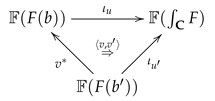 whose component at a morphism of is the morphism of
depicted as
whose component at a morphism of is the morphism of
depicted as
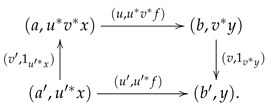



Then, the induced homomorphism
is the composite of the homomorphisms
Corollary 3.
For any natural system on there is a natural first quadrant spectral sequence
where is the natural system on defined in Equation (24).
Proof.
Let be the double cochain complex associated to the bicosimplicial abelian group in Equation (19). Fixing any , and taking homology in the vertical complex , we have
Taking now the cohomology again, we have , whence the result follows from Corollary 2. □
Note that, when is the identity arrow of any object b of , then functor in (22) is the induced one on the category of factorizations by the canonical inclusion functor
So, in this case, we can write the corresponding cohomology group Equation (23) simply as . For any , we have the -module
which carries every morphism to the composite homomorphism
where
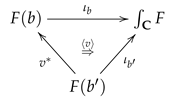 is the natural transformation defined, at any object x of , by
is the natural transformation defined, at any object x of , by

There is, for any integer , a morphism of natural systems on
where, recall, the -module is regarded as a natural system by composition with the target functor in Equation (5). Its component at any morphism in is the homomorphism
induced by the natural transformation ,
 which is defined on any morphism of by
which is defined on any morphism of by
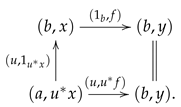


Following to Pirsahvili–Redondo [], we say that the natural system is h-local provided the morphism in Equation (27) is an isomorphism, for all . This means that, for any arrow in , the cochain map
 is a homology isomorphism. We call the natural system local whenever the natural transformations induces an isomorphism of natural systems on , that is, if for any in ,
is an isomorphism (note that this condition is a bit weaker than the corresponding one stated in []). Clearly every local natural system on is h-local, as well as every -module is a local natural system. The spectral sequence by Pirsahvili–Redondo in ([] Theorem 5.2) (cf. also Gálvez–Neumann–Tonks ([] Theorem 2.5)) and ([] Theorem 2.16)) appears now as a particular case of the spectral sequence in the above Corollary 3.
is a homology isomorphism. We call the natural system local whenever the natural transformations induces an isomorphism of natural systems on , that is, if for any in ,
is an isomorphism (note that this condition is a bit weaker than the corresponding one stated in []). Clearly every local natural system on is h-local, as well as every -module is a local natural system. The spectral sequence by Pirsahvili–Redondo in ([] Theorem 5.2) (cf. also Gálvez–Neumann–Tonks ([] Theorem 2.5)) and ([] Theorem 2.16)) appears now as a particular case of the spectral sequence in the above Corollary 3.

Corollary 4.
For any h-local natural system on there is a natural spectral sequence
where is the natural system on defined in Equation (26).
The spectral sequence in Corollary 3 involves some invariance results, as we show below.
Corollary 5.
Let be functors, let be a natural transformation, and let be a natural system on . If, for any arrow in , the functor induces isomorphisms
then the functor also induces isomorphisms
Proof.
For any arrow of , the square
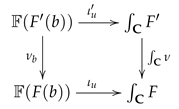 commutes. Therefore induces isomorphisms
commutes. Therefore induces isomorphisms

Since these are natural in u, it follows that induces an isomorphism of natural systems on between and . Then, for any integers , there are natural isomorphisms
and the result follows from the spectral sequences in Corollary 3 for F and and and , respectively. □
Recall now that a functor is called a twisted system of coefficients on the diagram of categories whenever, for any object b of , is a local system of coefficients on the category ; that is, provided that, for any arrow in , the induced is an isomorphism, see ([] Definition 2.1). The following invariance result was proved by Moerdijk–Svensson in ([] Theorem 2.3).
Corollary 6.
Let be functors. Suppose is a natural transformation such that all the functors , , are weak homotopy equivalences of categories. Then, for any twisted system of coefficients on F, ν induces natural isomorphisms
Proof.
For any twisted system of coefficients on F, the induced homomorphisms are isomorphisms. Since, for any in , we have , the hypothesis of Corollary 5 above hold, whence the result follows. □
The following terminology is suggested by T. Pirashvili.
Definition 1.
A weak homotopy equivalence of categories is a Baues–Wirsching weak homotopy equivalence (resp. a Roos–Watts weak homotopy equivalence) provided that, for any natural system on (resp. -module), the induced homomorphisms , , are all isomorphisms.
For instance, if is any functor with a left or right adjoint, then it is a Baues–Wirsching weak homotopy equivalence. This fact follows from ([] Lemma 1.5, p. 10). See also ([] Lemma 2.2), ([] Corollary 2.3), and ([] Corollary 4.3).
Corollary 7.
Let be functors. Suppose is a natural transformation such that all the functors , , are Baues–Wirsching (resp. Roos–Watts) weak homotopy equivalences, then also is.
Proof.
This follows from Corollary 5. □
4. On the Weak Equivalence
Throughout this section, is a small category and is a functor. For any morphism of , we write for the simplicial map . Since is simplicial, for any map in , we have , that is, the square below commutes.
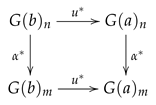

In particular, every functor gives rise to the simplicial maps, see Equation (6),
4.1. The Involved Constructions
The simplicial replacement of G of Bousfield–Kan ([] Chapter XII, §5) produces the bisimplicial set
whose -simplices are pairs where is a functor and is a q-simplex of . If and are maps in , the induced maps
are respectively defined on any -simplex as above by
In particular, its horizontal and vertical face maps act by
The homotopy colimit construction on G is the simplicial set
Its n-simplices are then pairs where is a functor and . If is any map in , then the induced map acts by
In particular, its face maps are given by
On the other hand, by composing G with the category of simplices functor , we get a diagram of categories on which we can apply the Grothendieck construction. This yields the small category
whose objects are triples , where , , and is a n-simplex of . A morphism consists of morphisms , of , and , of , such that . Composition in is given by .
Let be the category of simplices of the homotopy colimit of G. Its objects are triples , where is a functor and . Its morphisms are those maps in such that and . We have the functor
which is defined on objects by , and on morphisms by
4.2. A Projective Resolution of the -module
To shorten some expressions, if is any -module and is an object of , then we write for , leaving understood the dimension n of the simplex x of .
Let be as in Equation (28). For any integers , let the set be equipped with the map
and let be the associated free -module. Thus, for each object of , is the free abelian group on the set of lists consisting of a functor , a simplex , a map in , and a morphism in , such that . Equivalently, we can take
the free abelian group on the set of triples consisting of a functor , a morphism in , and a map in . If is any morphism of the category , then the induced homomorphism is given on generators by .
These provide us of a bisimplicial -module
in which, for any maps and in the simplicial category, the induced morphisms at any object of ,
are the homomorphisms acting on generators by
In particular, the horizontal and vertical face homomorphisms
are defined on generators by
Let be the complex associated to the simplicial -module diagonal of . Thus, and, at any object of , the differential is given on generators by
Lemma 2.
is a projective resolution of the -module . Hence, for any -module ,
Proof.
Let us write as in Equation (31). There is an augmentation which, at any object of , is given by the homomorphism
that carries all generators of to the generator of . Since every -module is free, whence projective, it suffices to prove that, for any object of , the augmented chain complex of abelian groups
is exact. To do this, let us fix any such and proceed as follows.
Let be the standard simplicial n-simplex, and let us consider the simplicial abelian group , , as a bisimplicial abelian group which is constant in the horizontal direction. Then, a bisimplicial homomorphism is given by the homomorphisms defined on generators by
where we have identified any object of with the functor such that . For any , the associated augmented chain complex of abelian groups admits a contracting homotopy k
 whence it is exact. Such a homotopy k is given by the homomorphisms
which act on generators by
where, for any and , is defined as in Equation (15). It follows from Dold–Puppe Theorem that the induced map on the associated augmented diagonal complexes ,
whence it is exact. Such a homotopy k is given by the homomorphisms
which act on generators by
where, for any and , is defined as in Equation (15). It follows from Dold–Puppe Theorem that the induced map on the associated augmented diagonal complexes ,
 is a homology isomorphism. Then, the exactness of Equation (33) follows from the exactness of the augmented chain complex at the bottom in the above diagram, as it has a contracting homotopy given by the homomorphisms
which are defined on generators as follows: is the map , and, for any , is the map and . □
is a homology isomorphism. Then, the exactness of Equation (33) follows from the exactness of the augmented chain complex at the bottom in the above diagram, as it has a contracting homotopy given by the homomorphisms
which are defined on generators as follows: is the map , and, for any , is the map and . □


By composing with the functor in Equation (29), every -module gives rise to a coefficient system on , and we have
Theorem 4.
For any -module , there are natural isomorphisms
Proof.
Let be any given -module. As we did before, for any object of we write instead of , and also, for any morphism of we write
for the induced homomorphism . Similarly, for any map in , we write
by the homomorphism . Thus, we have the equalities
that is, both inner triangles in the diagram below commutes.
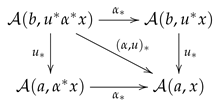

The induced coefficient system on carries an n-simplex to the abelian group and, for any map in , the attached is the homomorphism
In particular, the cofaces are the homomorphisms
Then, the standard cochain complex consists of the abelian groups
with coboundary given by
Now, let be the bisimplicial -module in Equation (31). By Proposition 1, there are isomorphisms of abelian groups
which carry an m-cochain to the morphism of -modules given, at any object of , by the homomorphism of abelian groups
These fit together to define an isomorphism of cochain complexes
In effect, for any , any object of , and any generator of , we have
Hence, the result follows from Lemma 2. □
Let X be a simplicial set. When we specialize Theorem 4 above to the case when is the only-one-arrow category and the functor with , then , the simplicial set X, , the category of simplices of X, and the comparison functor (Equation (29)), , is the identity on . Therefore, we obtain the following well-known result, already mentioned in Section 2 as Fact 1.
Corollary 8.
For any simplicial set X and any -module , there are natural isomorphisms
Returning to the general case, if is any -module, we have are natural isomorphisms
whence our second main result in the paper follows
Corollary 9.
The functor μ in Equation (29) is a Roos–Watts weak homotopy equivalence; that is, for any -module , μ induces isomorphisms
Remark 3.
For any -module , the spectral sequence in Corollary 4 can be written as
where is the -module assigning to each object b of the q-th cohomology group of the simplicial set with coefficients in the -module obtained by restriction of via the inclusion functor (25).
Remark 4.
Let us say that a weak homotopy equivalence of simplicial sets is Gabriel–Zisman weak homotopy equivalence provided that, for any coefficient system on Y, the induced are isomorphisms for all . That is, whenever is a Roos–Watts weak homotopy equivalence. The invariance result in Corollary 7, tell us that if is a natural transformation between diagrams of simplicial sets , such that every , , is a Gabriel–Zisman weak homotopy equivalence, then the induced functor is a Roos–Watts weak homotopy equivalence (cf. Moerdijk–Svensson ([] Corollary 2.5)).
Finally, it is worth noting that both Theorem 3 and Corollary 9 can be useful in combination. For example, for any diagram of categories , there is a canonical functor
induced by the natural transformation , whose component at any object , is the last vertex functor , see Equation (8). We now can prove
Corollary 10.
For any functor , the functor L above is a Roos–Watts weak homotopy equivalence.
Proof.
We know that every last vertex functor is a weak homotopy equivalence (see, e.g., Illusie ([] Chapitre VI, Thèormé 3.3)). Then, the functor L is also a weak homotopy equivalence by Thomason ([] Corollary 3.3.1). Furthermore, since the square of functors
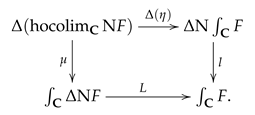 commutes, for any -module , the induced homomorphisms are the composite of the isomorphisms
□
commutes, for any -module , the induced homomorphisms are the composite of the isomorphisms
□

Funding
This research received external funding from FQM-379: Algebra y Teoría de la Información.
Acknowledgments
The author is much indebted to the anonymous referees, whose useful observations greatly improved our exposition.
Conflicts of Interest
The author declares no conflict of interest.
References
- Thomason, R.W. Cat as a closed model category. Cahiers de Topologie et Géométrie Différentielle Catégoriques 1980, 21, 305–324. [Google Scholar]
- Gabriel, P.; Zisman, M. Calculus of Fractions and Homotopy Theory; Springer: Berlin, Germany, 1967. [Google Scholar]
- Quillen, D. Homotopical algebra, Lecture Notes in Math; Springer: Berlin, Germany; New York, NY, USA, 1967; Volume 34. [Google Scholar]
- Baues, H.J.; Wirsching, G. The cohomology of small categories. J. Pure Appl. Algebra 1985, 38, 187–211. [Google Scholar] [CrossRef]
- Thomason, R.W. Homotopy colimits in the category of small categories. Math. Proc. Camb. Philos. Soc. 1979, 85, 91–109. [Google Scholar] [CrossRef]
- Pirashvili, T.; Redondo, M.J. Cohomology of the Grothendieck construction. Manuscripta Math. 2006, 120, 151–162. [Google Scholar] [CrossRef][Green Version]
- Gálvez-Carrillo, I.; Neumann, F.; Tonks, A. André spectral sequences for Baues–Wirsching cohomology of categories. J. Pure Appl. Algebra 2012, 216, 2549–2561. [Google Scholar] [CrossRef]
- Gálvez-Carrillo, I.; Neumann, F.; Tonks, A. Thomason cohomology of categories. J. Pure Appl. Algebra 2013, 217, 2163–2179. [Google Scholar] [CrossRef][Green Version]
- Bousfield, A.; Kan, D.M. Homotopy Limits, Completions and Localizations; Springer Science & Business Media: Berlin/Heidelberg, Germany, 1972; Volume 304. [Google Scholar]
- Moerdijk, I.; Svensson, J.-A. A Shapiro lemma for diagrams of spaces with applications to equivariant topology. Compos. Math. 1995, 96, 249–282. [Google Scholar]
- Mac Lane, S. Categories for the Working Mathematician, 2nd ed.; GTM 5; Springer: New York, NY, USA, 1972. [Google Scholar]
- Illusie, L. Complex Cotangent et Déformations II; Lecture Notes in Math. 283; Springer: Berlin, Germany, 1972. [Google Scholar]
- Roos, J.-E. Sur les foncteurs dérivés de . Applications. C. R. Acad. Sci. Paris 1961, 252, 3702–3704. [Google Scholar]
- Watts, C.E. A homology theory for small categories. In Proceedings of the Conference on Categorical Algebra, La Jolla 1965; Springer: New York, NY, USA, 1966; pp. 331–336. [Google Scholar]
- Goerss, P.G.; Jardine, J.F. Simplicial Homotopy Theory; Springer Science & Business Media: Berlin/Heidelberg, Germany, 2009. [Google Scholar]
- Grothendieck, A. Catégories fibrées et descente. Exposé VI in Revtêments étales et groupe fondamental, SGA1 (1960-61). In Documents Mathématiques; Societé Matheématique de France: Paris, France, 2003; Volume 3. [Google Scholar]
- Carrasco, P.; Cegarra, A.M.; Garzón, A.R. Classifying spaces for braided monoidal categories and lax diagrams of bicategories. Adv. Math. 2011, 226, 419–483. [Google Scholar] [CrossRef]
- Cegarra, A.M. Cohomology of diagrams of groups. The classification of (co)fibred categorical groups. Int. Math. J. 2003, 3, 643–680. [Google Scholar]
- Cegarra, A.M. Equivariant Brauer groups and cohomology. J. Algebra 2006, 296, 56–74. [Google Scholar] [CrossRef][Green Version]
- Franjou, V.; Friedlander, E.M.; Pirashvili, T.; Schwartz, L. Rational Representations, the Steenrod Algebra and Functor Homology; Panoramas et Synthéses; SociétéMathématique de France: Paris, France, 2003; Volume 16. [Google Scholar]
- Muro, F. On the functoriality of cohomology of categories. J. Pure Appl. Algebra 2006, 204, 455–472. [Google Scholar] [CrossRef][Green Version]
© 2020 by the author. Licensee MDPI, Basel, Switzerland. This article is an open access article distributed under the terms and conditions of the Creative Commons Attribution (CC BY) license (http://creativecommons.org/licenses/by/4.0/).
